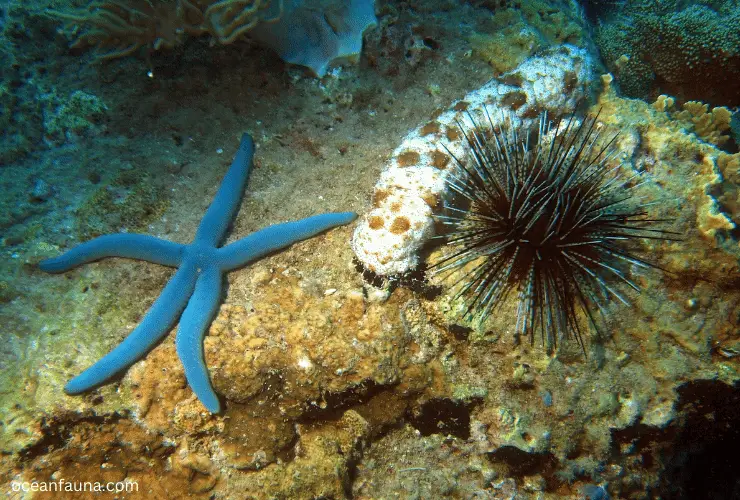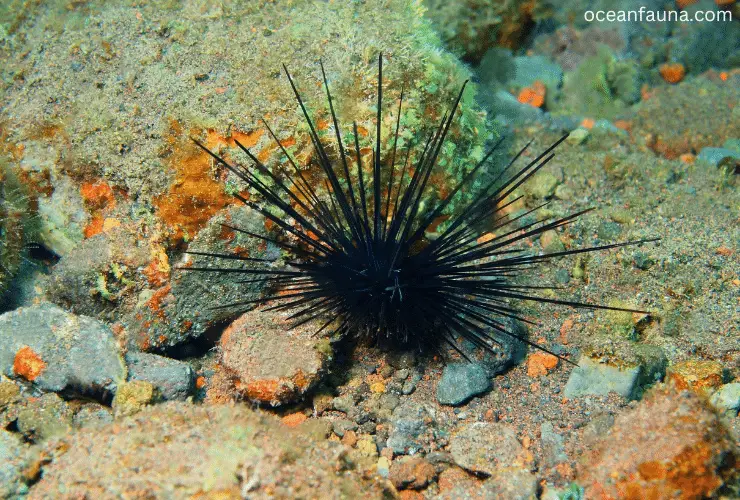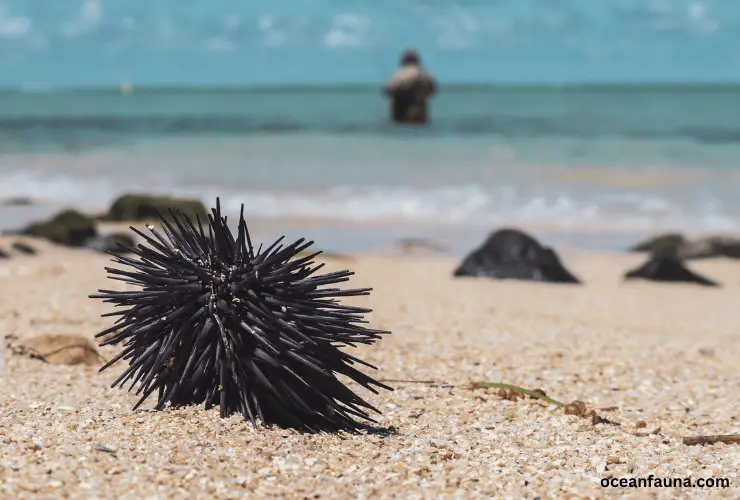Sea urchins live in oceans. From intertidal to the deep ocean, you can expect them. Over 950 species of sea urchins live in waters of every temperature, either warm or cold. They are in shallows on coral reefs as well as deep on rocky seabeds.
The habitat of sea urchins decides their species, food, survival limits and habits. You may better stay tuned to read more about the living aptitude of the sea urchin.
Where Do Sea Urchins Live? Do Sea Urchins Live in All Oceans?
Yes, they do live in all types of oceans. They live at the tide line to the depth of 15000 feet. It is because they cannot swim and have to stay on the ocean floor.
At the intertidal area, the urchins live in worn-away rock holes that also protect them from predators. Listed below are some facts about the habitat of sea urchins:
- Sea urchins are both warm and cold saltwater settlers.
- They are never to be found in fresh waters.
- An abundance of species lives in the oceans of warmer climates, such as temperate and tropical regions.
- Naming the oceans pregnant with sea urchins, we may include:
- Atlantic Ocean in the Caribbean
- Pacific Oceans near Hawaii
- Indian and Pacific oceans around Australia
Do Sea Urchins Live in Shallow or Deep Water?
Naturally, sea urchins have a larger number in shallow waters near the coasts. The diversity of the habitat of the sea urchins is not a hidden fact.
Shallow and deep, the urchins are better found in both ocean levels. Be it a sandy bottom, seagrass bed, or underneath the red mangrove trees, they can survive all these terrains.
Note: Shallow water~ Sea urchins live in shallow waters feeding on kelp forests. Here, they are seen in rock pools and seaweed.
Where Do Sea Urchins Like to Live?
Unlikely to know, yet it is a fact that sea urchins do not like to live in the thriving vegetation of oceans. They prefer the barren areas of the seabed more.
Sea urchins vary in habitat according to their type. The population density is higher where the wave action can disturb them.

Due to the expected storms, they live better in crack holes and rock cavities in winter.
Although found in all marine ecosystems, they are happy living on temperate and tropical coasts between the surface. It is close to photosynthetic food sources.
Do Sea Urchins Die Out of Water?
Yes, sea urchins die out of water. They are one of those living creatures whose delicacy is top of the list.
Despite the fact that they give you a spiny shock, the anatomy of the sea urchin is sensitive and requires a specific environment.
The body’s moisture is retained throughout the life of the sea urchin. All the above discussion makes it clear that they require water to live as a must.
Note: Shingle urchin is one of a kind that can stay out of water for hours. It lives on the seashore lines and is resistant to wave action.
Can You Keep a Sea Urchin As Pet?
Yes, it is kept as a pet and you can have the chance to do so. But like all other animals, you need to be cautious about its habitat, space needs, feed and vulnerable aspects of survival to let it stay alive.
The following tips would help you to keep it safe in your saltwater tank:
- Have thorough research on sea urchin living and needs and its compatibility with other fish.
- Plan to give one gallon of tank space per inch of a sea urchin’s maximum size.
- Water temperature must linger near 80 degrees Fahrenheit. Plus, the salinity of the water should be near the salinity of seawater.
- Kelp, seaweed, laminaria and egregia are the diet of sea urchins, but the diet varies according to the type of urchin.
- Maintain the cleanliness of the tank.
Do Sea Urchins Need Oxygen?
Yes, they do. They get the oxygen from the water through tube feet.
Sea urchins have a unique feature called the water vascular system. This system has many works to do, including transferring oxygen to the urchin’s body.
The urchin stays still and absorbs water’s dissolved oxygen through tube feet. The tube feet transfer it to the gills at the mouth’s outer ring.
When the oxygen levels of urchins are low, carbon dioxide is released through the anus and the tube feet supply oxygen to the body.
The above-mentioned example explains more about the purple sea urchin. One thing you should know is that the oxygen intake by the urchin is through diffusion.
How Do You Keep a Sea Urchin Alive?
The question is more for those among you who would keep an urchin as a pet. Keeping it as a pet, we already know what precautions we must take.
Still, the golden rules must be followed to be kept the sea urchin alive when it is at your disposal. Keep an eye on the points mentioned:
- Take the body of the urchin from warm to cold by placing it in a double container, having ice in the outer container.
- Make the tank filled with seawater to reach the balance of salinity.
- Keep the tank light with a lesser population of the sea for better oxygen. This will not fill the tank with dead animal bodies or their wastes.
- Avoid water contamination as they are fragile and can’t survive poor water quality.
How Long Can Sea Urchins Live Without Food?
The lifespan of sea urchins can reach up to 50 years. Dr. Rumrill says they go dormant and under slower metabolism during a food shortage.
Sea urchins can survive on literally no food for years and switch to hibernation mode. They absorb nutrients from seawater and stay alive.

You can say it is not good, which can starve them to death. Their resilience is amazing.
Can You Touch a Sea Urchin in An Aquarium?
Yes, you can. Consider caution as you read on glassware packaging: handle it carefully! The sea urchins won’t sting you if you don’t bump into them or you don’t hold them hard.
Do Sea Urchins Like Clean Water?
Yes, sea urchins are very sensitive to their environment. The contaminated water bodies cause deformities in the urchin larvae. It is the plastic chemical that affects their health.
On the other hand, clear water differs from what a sea urchin would prefer as the clear water has less nutrients.
FAQs
What zone do sea urchins live in?
The sea urchins live in intertidal zones 100 feet in depth in the ocean. However, they change their location when they hide from predators in rock cavities. They also roam about in search of food.
How many years do sea urchins live?
The red sea urchins of Southern California live up to 50 years, but there is evidence that the red sea urchins in British Columbia, Canada, can live for 100 years.
Where do sea urchins live in Australia?
Centrostephanus rodgersii, also known as purple sea urchin, is found off the coast of New South Wales, eastern Victoria, the east coast of Tasmania and the eastern Bass Strait Islands in Australia.
Conclusion
Sea urchinsare unique creatures that can make a whole world of their own under the ocean. They settle on kelp forest once and then you find them settling in the same area for infinity.
They create an urchin barren, totally cleaning the area of its natural vegetation. They live in all 5 oceans of the world in varying depths according to their type.
Despite the over-control of sea urchins on sea life, environmental studies claim them to be useful for measuring the impact of global warming.


3 thoughts on “Where Do Sea Urchins Live?”